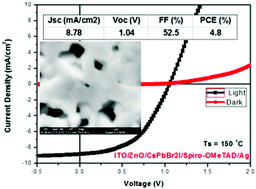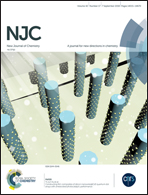Fabrication of planar heterojunction CsPbBr2I perovskite solar cells using ZnO as an electron transport layer and improved solar energy conversion efficiency†
Abstract
Inorganic lead halide perovskite solar cells with mixed halides have achieved reasonable power conversion efficiency with the advantage of enhanced stability. In this work, we report the fabrication of an all-inorganic cesium lead bromoiodide based planar perovskite solar cell with a ZnO electron transport layer. The method described herein includes the use of one step spin coating solution processing using a solvent mixture (DMF + DMSO) to avoid the solubility issues of CsPbBr2I perovskite in DMF. The substrate temperature during spin coating was found to be a critical parameter to generate the required crystalline morphology of the perovskite thin films. Post-annealing of the as-deposited perovskite film at 275 °C led to the formation of the cubic phase of CsPbBr2I with an optical band gap of 2.06 eV. Interestingly, cubic shaped CsPbBr2I morphology was obtained via single-step spin-coating processing that otherwise required two-step solution deposition of the hybrid perovskite. The best performing devices achieved 4.8% power conversion efficiency with minimal hysteresis and enhanced thermal and photo-stability. Owing to enhanced thermal and photo-stability, inorganic perovskites appear as viable alternatives to hybrid organic–inorganic perovskites for solar cell applications.



 Please wait while we load your content...
Please wait while we load your content...